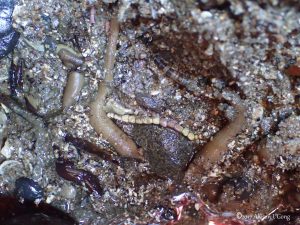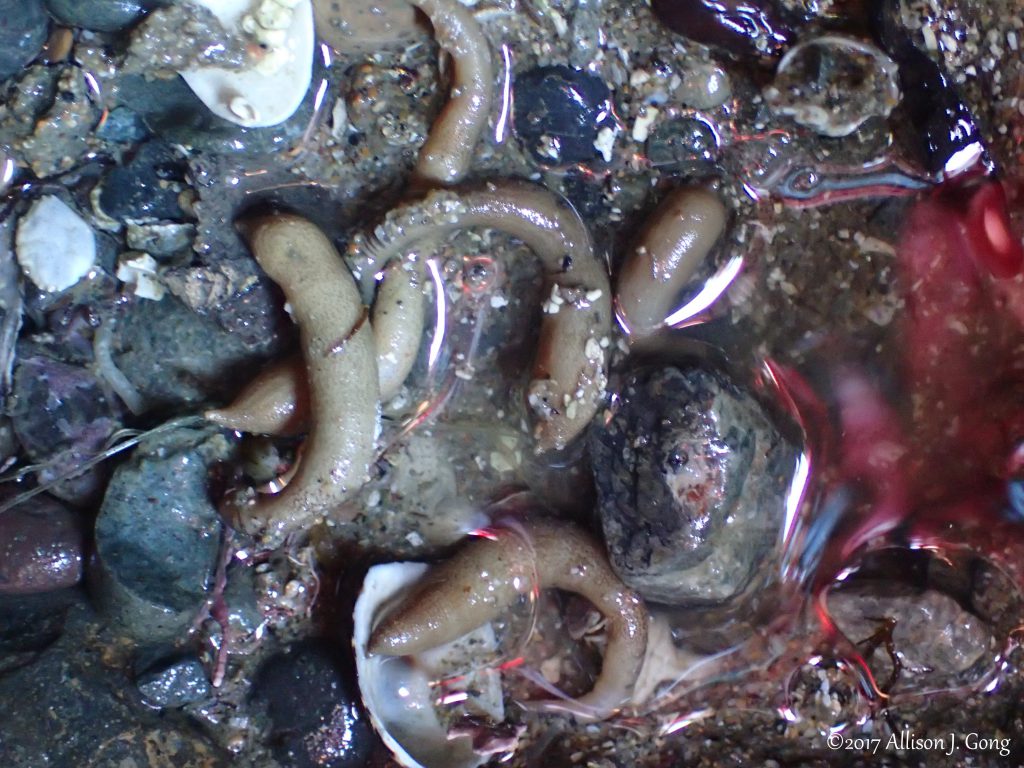If I ask my invertebrate zoology students to name three characteristics of the Phylum Annelida, they would dutifully include segmentation and chaetae (bristles) in the list. And they would be correct. Annelids, for the most part, are segmented and many of them have chaetae. But in biology there are many exceptions for every rule we teach, and it’s these exceptions that make a deeper study of biology so rewarding.
A couple of weeks ago I did some collecting in the intertidal at Pigeon Point. It was a very accommodating low tide, and I had a lot of time to poke around and explore. I found an area that had several decently sized rocks that I could turn over, and had fun seeing what lives on the side away from the light. Some of the animals on the underside of rocks are the common ones you see everywhere–turban snails, limpets, Leptasterias stars, and the like. Some, however, prefer a life of darkness and actively move away from the sun when their rock is turned over. And others happen to live in the sand under the rock and might not care one way or the other about the light.
Peanut worms, scientifically known as sipunculans, are delightful small worms that in my opinion are vastly underappreciated. This is understandable, as they are usually hidden in sand or rubble and aren’t exactly conspicuous even when uncovered. Phascolosoma agassizii is our local sipunculan. Like all sipunculans it is unsegmented, and it has no chaetae. Peanut worms used to be elevated to their own phylum, the Phylum Sipuncula; however, molecular evidence shows that they are indeed annelids despite their apparent loss of key features such as body segmentation and chaetae.
They do look vaguely peanut-ish, don’t they? They’re small, maybe 6 cm all stretched out, which you hardly ever see. Phascolosoma agassizii is a grayish pink color, with irregular black stripes that usually don’t form complete hoops around the body. Peanut worms are sedentary, living with most of the body buried in sand, rubble, shell debris, kelp holdfasts, etc. One of the weird things about them is that the mouth in located on the distal end of a long tube called the introvert. Most of the time the introvert is stuffed inside the main body region, or trunk. It is eversible and unrolls from the inside out, sort of like when you remove a long sock by pulling the top edge down over your leg and off your foot. The mouth on the end of the introvert is surrounded by short sticky tentacles, and the introvert dabs around to pick up organic deposits from the surfaces. Mucus and cilia on the tentacles convey the yummy organic gunk to the mouth, and a pharynx pushes food through to a long esophagus that runs the length of the introvert and leads to the long coiled intestine in the trunk.
Watch these peanut worms extending and retracting their introverts. Cute, aren’t they?
I brought three peanut worms back to the lab with me, where they are happily living in my sand tank. Their housemates are ~15 sand crabs (Emerita analoga) and a clump of tube-dwelling polychaetes (Phragmatopoma californica). I never see them unless I dig them up from the sand, which leads me to believe that they do most of their feeding at night. Either that or they actually do actively shy away from the light.
Despite not sharing much in the way of apparent morphological similarity with more typical annelids, sipunculans are indeed annelid-like in other ways. Many of their internal structures are like those of annelids, and at least their early development (cleavage pattern and differentiation of tissue layers) follows the annelidan pathway. The species that have indirect development have a trochophore larva, typical of the marine annelids, that in some cases morphs into a second larval stage called a pelagosphera.
Sipunculans are the poster child for Animals That Are Not What They Seem. But they are interesting in their own way, and I always have a “yay!” moment when I find them in the field. It’s really hard not to make sound effects as they’re rolling their introverts in and out. You should try it yourself some time.


